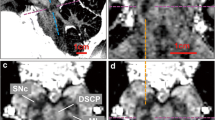Summary.
The two principle targets for deep brain stimulation or lesioning in patients with Parkinson's disease, the subthalamic nucleus (STN) and the globus pallidus internus (GPi), reveal a high degree of individual variability which is relevant to the planning of stereotactic operations. Both nuclei can clearly be delineated in T2WI spin echo MRI which was acquired under stereotactic conditions in general anesthesia before surgery. Such images of 35 patients served for retrospective morphometric analysis of different basal ganglia nuclei (STN, GP, red nucleus, and substantia nigra) and several anatomical landmarks (anterior and posterior commissure, maximum width of third ventricle, brain length and width). The average AC-PC distance was 25.74 mm (range 21 to 29 mm) and is in agreement with previous studies. On average, the center of the STN was located 12.65 mm (±1.3) lateral from the midline as determined 3 mm ventral to the intercommissural plane. The average width of the third ventricle was 7.05 mm (±2.41). The width of the third ventricle correlated with the laterality of the STN (rright=.78; rleft=.83) and GP (rright=.76; rleft=.68). Although to a lesser extent, significant correlations were also observed between the laterality of the STN and brain width, improving prediction of STN laterality by multiple linear regression analysis (rright=.82; rleft=.87). Similarly, the laterality of GP correlated with brain width. In addition, gender-specific differences were detected. The STN and GP was located farther lateral in males which may be due to overall brain anatomy as gender-specific differences were also observed for brain width and length and AC-PC distance. MRI-based in vivo-localization of different basal ganglia nuclei extend statistical information from common histological brain atlases which are based on a limited number of brains. The correlations observed between different basal ganglia nuclei, i.e. the STN and GPi, and anatomical landmarks may be useful for surgical planning.
Similar content being viewed by others
Author information
Authors and Affiliations
Additional information
Published online October 10, 2002
Acknowledgments This work is part of a doctoral thesis by X. Zhu submitted to the Christian-Albrechts-Universität zu Kiel. We are indebted to Dr. G. Brinkmann from the Department of Radiology for his advice and committed help in establishing the MRI-sequences into clinical practice. We thank Prof. Jansen (Section of Neuroradiology) and the technical staff of the MRI Department, Mrs. C. Bahr and Mrs. U. Huβ, for enduring support. We also thank Dr. G. Neumann with his colleagues from the Department of Anesthesiology for performing general anesthesia during MR-scanning. Finally, the helpfulness of our OR-nursing staff is greatly appreciated.
Correspondence: W. Hamel, M.D., Klinik für Neurochirurgie, CAU Kiel, Weimarer Str. 8, 24106 Kiel, Germany.
Rights and permissions
About this article
Cite this article
Zhu, X., Hamel, W., Schrader, B. et al. Magnetic Resonance Imaging-Based Morphometry and Landmark Correlation of Basal Ganglia Nuclei. Acta Neurochir (Wien) 144, 959–969 (2002). https://doi.org/10.1007/s00701-002-0982-x
Issue Date:
DOI: https://doi.org/10.1007/s00701-002-0982-x




